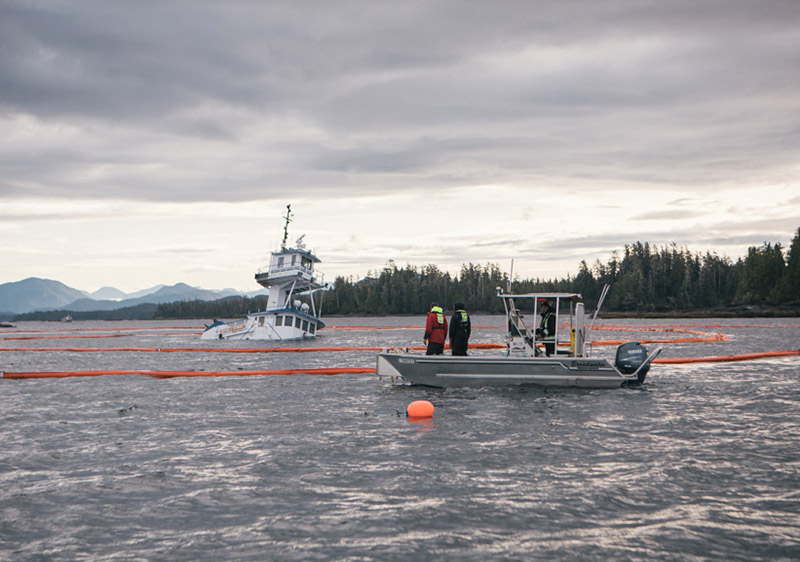Responders worked through the weekend in an effort to contain a diesel spill near Bella Bella, British Columbia, the result of a Kirby Offshore Marine ATB running hard aground at the entrance to the Seaforth Channel early Thursday morning.
By Monday, the barge DBL 55 had been removed from the scene and anchored at the mouth of nearby Dundavan Inlet, according to the Canadian Coast Guard, which is working with Kirby, the Western Canada Marine Response Corporation, officials from the Heiltsuk First Nation, and other government agencies to respond to the spill. The barge had been empty of cargo at the time of the grounding, but some fuel from the attached tug Nathan E. Stewart was later pumped into one of its tanks. The ATB tug Nathan E. Stewart, source of the spilled diesel, remained partially submerged at the site of the grounding Monday evening, but was resting on the bottom and considered stable with all vents plugged, the Coast Guard said.
Houston-based Kirby said the tug had been loaded with 59,924 gals. of diesel fuel when it ran aground, and that 6,554 gals. of diesel had been pumped from the tug into a tank on the barge before the pumps failed due to water in the engine room. Kirby confirmed that the tug was also carrying 639 gals lube oil, 550 gals hydraulic oil, 550 gals gear oil, 969 gals dirty bilge water. The amount of fuel spilled had not been confirmed as of Monday evening.
Responders began hot tapping operations Monday evening, and lightering operations to remove the remaining fuel from the tug were expected to take approximately 40 hours to complete. Crews planned to work around-the-clock until all remaining fuel was removed. As of 6 a.m. Tuesday, the Coast Guard reported that 6,200 gals. of fuel had been removed from the tug overnight. The Coast Guard said salvage plans were still being developed, but initially called for a crane to be brought in to lift the tug onto a barge for removal.

Sheen is visible on the water on Oct. 18 near the site of the grounding. Canadian Coast Guard photo.
Observations on Monday showed some amount of diesel surfacing from the tug, and some observed to have escaped containment booming during the high tide. Two overflights of the site on Monday showed a light sheen within the containment boom and outside of it. Sheen was also observed on the south side of Seaforth Channel and around the mouth of Gale Channel.
The ecological sensitivity of the region, part of the Great Bear Rainforest, has made environmental concerns a top priority. The Heiltsuk First Nation manages a traditional fishery in the area, and said that the spill threatens dozens of species, including manila clams. The manila clam fishery had been due to open in about three weeks, Heiltsuk officials said. On Friday, Fisheries and Oceans Canada closed the fisheries in the area.
"It's not if...but when...happened" damage done. Heiltsuk assessing effects of spill & felt widespread by Nation. GBR no place for tankers. pic.twitter.com/h9ymB8MKsX
— Marilyn Slett (@bellabellabc) October 14, 2016
On Monday, BC Minister of Transport Marc Garneau issued a statement praising the Heiltsuk for their initial response efforts and listing the "safety and protection of the public and the environment" as the government's first priority. Garneau also hinted at possible changes to come to marine safety policies.
"Improving marine safety is a key part of my mandate as Minister of Transport and I take this situation very seriously," Garneau said. "The Nathan E. Stewart incident underlines the need for changes in the way we respond to marine pollution incidents, and that is why I am currently working on a coastal strategy to improve marine safety in a meaningful way."





